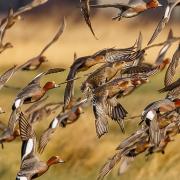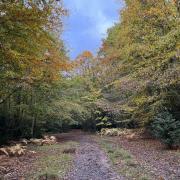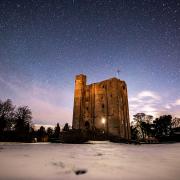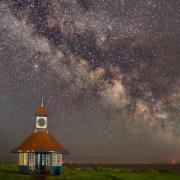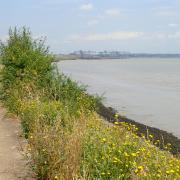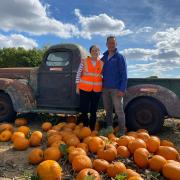Nestled between the north bank of the Crouch Estuary and the quaint village of North Fambridge lies a wild coastal reserve that's of international importance for conservation. Easily accessible via the North Fambridge Railway Station, this is the ideal destination for a day out – whether you are escaping the hustle and bustle of busy city life, or simply enjoying the refreshing sea breeze that washes over the seawalls from the River Crouch.
![Look out for the hares...]() Look out for the hares... (Image: Brian Clark.) Tranquil and sedentary at first glance, this nature reserve is more ‘peace’ than ‘quiet’. As you follow along the pathway that runs along the outskirts of the reserve, stop and listen for a while - what can you hear? The whisper of reedbeds being tickled by the winds. The sploshes of wading birds dancing in the muddy marshes. The buzz and chirps of insects flittering through the long blades of grass of grazing marshland. The summer-sweet melody of skylarks hovering high in the air to sing to all around. The honking of geese announcing their arrival from transatlantic pastures as the summer comes to an end. This is the soundscape of Blue House Farm nature reserve.
Look out for the hares... (Image: Brian Clark.) Tranquil and sedentary at first glance, this nature reserve is more ‘peace’ than ‘quiet’. As you follow along the pathway that runs along the outskirts of the reserve, stop and listen for a while - what can you hear? The whisper of reedbeds being tickled by the winds. The sploshes of wading birds dancing in the muddy marshes. The buzz and chirps of insects flittering through the long blades of grass of grazing marshland. The summer-sweet melody of skylarks hovering high in the air to sing to all around. The honking of geese announcing their arrival from transatlantic pastures as the summer comes to an end. This is the soundscape of Blue House Farm nature reserve.
![The reserve's wetlands are a haven for wildlife.]() The reserve's wetlands are a haven for wildlife. (Image: Essex Wildlife Trust.) Often as the summer comes to an end, we say goodbye to wildlife as it takes refuge from the cold. However, at Blue House Farm, autumn and winter wave a welcoming hand to a new hoard of wildlife. The extensive area of flooded marsh is the beating heart of this wild coastal reserve. In October, thousands of brent geese flock from Siberia, grazing on the flat fields and enjoying the nearby estuary. Myriads of waterfowl and wading birds like golden plover, curlew, teal and shoveler add to the commotion of a busy habitat and are all species to spot on your scenic stroll.
The reserve's wetlands are a haven for wildlife. (Image: Essex Wildlife Trust.) Often as the summer comes to an end, we say goodbye to wildlife as it takes refuge from the cold. However, at Blue House Farm, autumn and winter wave a welcoming hand to a new hoard of wildlife. The extensive area of flooded marsh is the beating heart of this wild coastal reserve. In October, thousands of brent geese flock from Siberia, grazing on the flat fields and enjoying the nearby estuary. Myriads of waterfowl and wading birds like golden plover, curlew, teal and shoveler add to the commotion of a busy habitat and are all species to spot on your scenic stroll.
![A lapwing nest - just one of the things you might spot...]() A lapwing nest - just one of the things you might spot... (Image: Essex Wildlife Trust) Recently, this nature reserved has been transformed to adapt to the changing climate. Essex is one of the driest counties in the UK, making it difficult for water-loving wildlife to find habitat in the spring and summer. For species like redshank and lapwing, this has resulted in declines of 43 per cent in just 25 years. To combat this, Essex Wildlife Trust has created 40 hectares of wetland at this reserve, thanks to generous funding from Biffa Award. With the addition of a perimeter fence, this area has become a protected zone for breeding birds. The Trust has since reported an increase in breeding waders and are continuing to monitor the wildlife that uses this new habitat.
A lapwing nest - just one of the things you might spot... (Image: Essex Wildlife Trust) Recently, this nature reserved has been transformed to adapt to the changing climate. Essex is one of the driest counties in the UK, making it difficult for water-loving wildlife to find habitat in the spring and summer. For species like redshank and lapwing, this has resulted in declines of 43 per cent in just 25 years. To combat this, Essex Wildlife Trust has created 40 hectares of wetland at this reserve, thanks to generous funding from Biffa Award. With the addition of a perimeter fence, this area has become a protected zone for breeding birds. The Trust has since reported an increase in breeding waders and are continuing to monitor the wildlife that uses this new habitat.
![A barn owl in flight.]() A barn owl in flight. (Image: Peter Hewitt.) Over the summer, wildlife sightings from the reserve have included black-tailed godwit, peregrine falcon, Temminck’s stint, spoonbills, curlew, greenshank and wood sandpiper. If you visit this autumn and winter, don’t forget to tag us in your sightings on social media @essexwildlifetrust.
A barn owl in flight. (Image: Peter Hewitt.) Over the summer, wildlife sightings from the reserve have included black-tailed godwit, peregrine falcon, Temminck’s stint, spoonbills, curlew, greenshank and wood sandpiper. If you visit this autumn and winter, don’t forget to tag us in your sightings on social media @essexwildlifetrust.
For a full list of Essex Wildlife Trust nature reserves to explore, see essexwt.org.uk/nature-reserves
Blue House Farm Chase, North Fambridge, Essex, CM3 6GU
essexwt.org.uk








